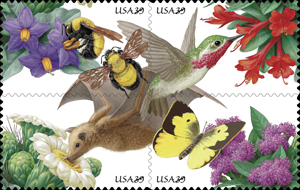The Importance of Pollinators
By Kathy Reshetiloff

Imagine the world without natural fibers, fruits, vegetables, or flowers. That's what our world would be like without pollinators—insects and other animals that pollinate our plants. Seventy-five percent of our flowering plants rely on insects, birds or bats to move pollen from one plant to another.
Pollination is critical to successful orchards, field crops, forage crops, home gardens, endangered species, and ecological restoration. As food producers and consumers, we all need to be aware of the importance of pollinators to plants and to our environment.
Birds and Bees and More
Most plants need to make seeds in order to reproduce. But many can't do it by themselves. To make seeds, the female part of the plant, called a pistil, needs pollen from the male part of the flower, called a stamen. Cross-pollination is the rule of thumb in the plant world. This means not only does pollen have to be transported from stamen to pistil but it also must come from separate flowers. Some plants rely on the wind to do this. Many others depend on insects and animals.
Pollinators, such as bees, use the nectar from flowers for food. While feeding, they get sticky pollen grains on their bodies and, moving from one flower to another, they transfer pollen to the pistils. Bees aren't the only pollinators. Other insects, like wasps, flies, butterflies, moths, and beetles are important pollinators. Larger animals, like birds (especially hummingbirds), flying foxes, bats, possums, lemurs, rodents and even a gecko, help move pollen.
Not Any Old Bug Will Do
Plants often help their specific pollinators find their way. This codependence is exhibited in many ways. Many night-pollinated flowers close during the day, to prevent thieves from getting at their nectar and pollen. On the other hand, many daytime-pollinated flowers close at night for the same reason. Flowers pollinated at night are usually white or pale yellow and very fragrant. This helps announce the flowers' presence. Day-flying insects usually pollinate darker-colored flowers, which are not as visible at night.
Flowers assist the pollinator in finding where the pollen or nectar is stored. Flowers often have bee lines, dots or color variations that direct the pollinator. Flowers have many shapes: bowl, cup, star or tube. Shapes are specific to pollinators and, in some cases, also keep out unwanted pollen collectors.
Disappearing Pollinators
Despite their importance to our economy and our lives, many pollinators are in trouble.
Honeybees raised specifically to pollinate crops are in decline. In the past 50 years, the domesticated honeybee population has declined by 50% due to parasitic mites, disease and pesticide poisoning and a phenomenon, Colony Collapse Disorder (CCD), where the bees go off in search of nectar and do not return to the hive . Wild pollinators are also disappearing at alarming rates due to habitat loss, pesticide poisoning, diseases and pests.
A healthy ecosystem provides pollinators with habitat for foraging, nesting, roosting and mating. Homes, businesses and roads are replacing the native fields, wetlands and forests that are home to many pollinators. In addition, many of the wildflowers used by pollinators for food, nesting or egg laying are rapidly disappearing.
Pesticides are also a threat. Many pesticides used on farms and backyard gardens are broad-spectrum types, meaning they can harm non-target species too. Many insecticides that get rid of plant pests are toxic to bees and other beneficial insects
Pollinators such as bats, butterflies and hummingbirds face even more problems. They may migrate many miles over the course of a year. These travelers need nectar-producing flowers all along their journeys. But wildflowers and natural habitats are being replaced by development. Less food and habitat is available to pollinators as they migrate.
You Can Help Pollinators.
Reduce the use of pesticides or, if possible, stop using them altogether. If you must use an insecticide, apply it in the evening when many pollinators are inactive.
Plant gardens filled with nectar-producing flowers that are native to your area. Refer to the Native Plants for Wildlife Habitat and Conservation Landscaping at www.nps.gov/plants/pubs/chesapeake/
Leave tree stumps, dead branches, and rotting trees on your property, if possible. They provide nests for some species of bees. Provide other nesting sites for birds, bats, butterflies, bees and other insects.
If you find a bee nest too close to your home, don't destroy it. Contact a local beekeeper or your state cooperative extension service for advice about removing the nest without harming the bees.
Pollinator Week is June 24-30, 2007. For more information on pollinators and how you can help them, go to www.pollinator.org.
Back
|

